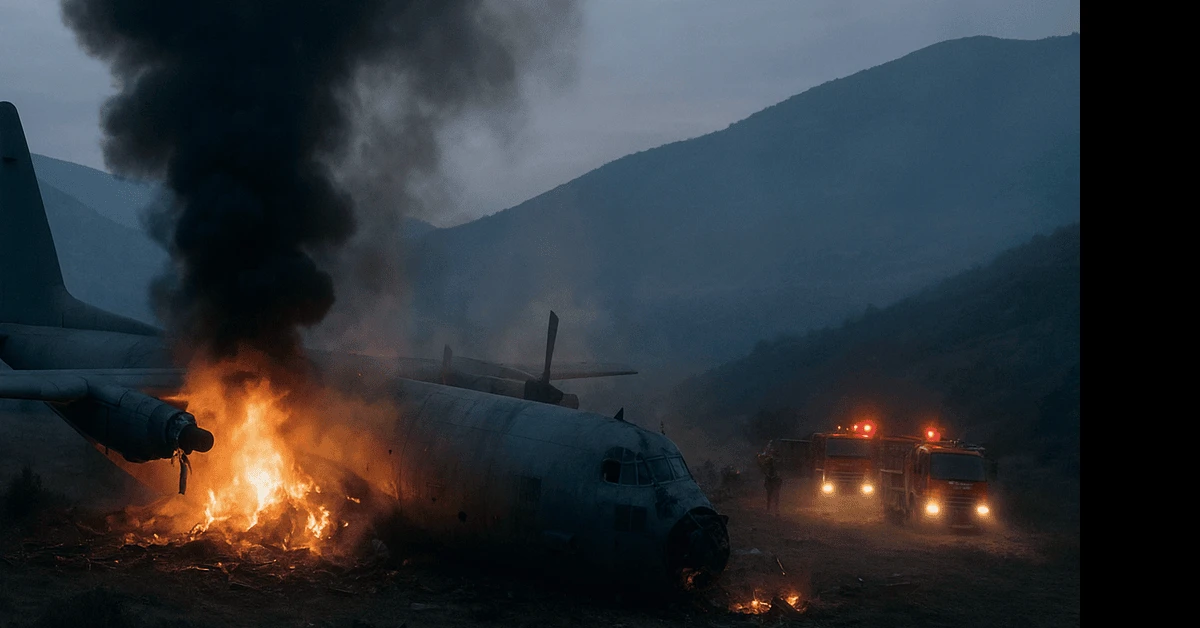Last Updated: November 12, 2025
Turkish Military C-130 Crashes in Georgia: All 20 Onboard Killed

On 11 November 2025, a Turkish military cargo aircraft — a Lockheed C-130 Hercules — crashed near the Georgian-Azerbaijan border, killing all 20 personnel aboard. The aircraft had taken off from Ganja, Azerbaijan, and was heading back to Türkiye when contact was lost shortly after entering Georgian airspace. The tragedy has sparked a joint investigation and widespread mourning across both nations.
1. Sequence of Events
According to preliminary reports, the C-130 was flying a routine logistical route carrying military staff and equipment. At around 8:30 p.m. local time, radar contact with the plane was suddenly lost over the Kakheti region of eastern Georgia. Moments later, residents reported hearing a loud explosion followed by flames visible from several kilometres away. Debris was later found spread over a large radius, suggesting the aircraft may have broken up mid-air before impact.
Emergency teams from Georgia and Türkiye reached the crash site quickly, but no survivors were found. The area has since been cordoned off while forensic teams collect evidence from the wreckage.
2. The Aircraft and Its Mission
The Lockheed C-130 Hercules is one of the most widely used military transport aircraft in the world. Known for its reliability and long operational history, it is used by Türkiye for troop transport, disaster relief, and international logistics. The flight from Azerbaijan to Türkiye was believed to be a personnel transfer mission following joint military exercises in the region.
Because the crash occurred in a sensitive border zone between Georgia and Azerbaijan, the incident has also raised diplomatic and operational concerns related to regional airspace management and cross-border coordination.
3. What Investigators Are Saying
Both Turkish and Georgian authorities have launched a detailed investigation into the cause of the crash. Teams are currently examining the aircraft’s black boxes, flight data records, and maintenance logs. Investigators are exploring several possibilities, including:
- Mechanical or engine failure: The C-130 is durable but aging, and mechanical stress could have caused a critical malfunction.
- Structural failure: Early reports of debris scattering before impact indicate the possibility of in-flight breakup.
- Weather conditions: The region experienced strong winds and low visibility at the time of the crash.
- Operational error or communication breakdown: Air traffic control logs are being analyzed to determine if communication was lost before the incident.
Officials from Türkiye’s defense ministry confirmed that no distress call was received prior to the crash.
4. Regional and Political Impact
This is one of the deadliest Turkish military aviation disasters in recent years. It highlights the growing risks associated with cross-border military transport missions in regions with complex geopolitical tensions. Georgia and Türkiye have both pledged full cooperation in the investigation, and Azerbaijan has offered logistical support to help with search and recovery efforts.
The crash may also prompt Türkiye to review maintenance schedules, pilot training procedures, and its broader military logistics strategy for flights operating across multiple airspaces.
5. Implications for Military Aviation Safety
While military aviation accidents are less frequent than in past decades, incidents like this emphasize ongoing safety challenges. Analysts suggest this tragedy could renew calls for:
- Modernization of older transport fleets.
- Enhanced tracking and airspace coordination for multinational operations.
- Improved maintenance oversight on aircraft older than 30 years.
- Expanded pilot training for low-visibility and border-region flight conditions.
Similar reviews followed past military crashes involving older aircraft models, leading to fleet upgrades and new safety procedures.
6. Human Toll and Tributes
All 20 individuals onboard — including flight crew and military personnel — were confirmed dead. Flags across Turkish military installations were lowered to half-mast, and leaders in Ankara expressed deep condolences to the families. Public memorials are being planned in both Türkiye and Georgia, reflecting the close cooperation between the two nations in responding to the disaster.
7. What Happens Next
The coming weeks will focus on recovering the aircraft’s black boxes and analyzing flight data to determine the exact cause. Türkiye is expected to issue a preliminary investigation report soon. Depending on the findings, similar C-130 aircraft may undergo additional safety inspections before being cleared for future flights.
Conclusion
The Turkish military C-130 crash in Georgia stands as a tragic reminder of the risks faced even during routine operations. As investigations continue, both nations are working to ensure transparency and prevent such a loss from recurring. The results of the inquiry could influence future aviation safety protocols not just in Türkiye, but across the region’s interconnected military operations.
Frequently Asked Questions (FAQs)
Q1: How many people were on board?
Twenty military personnel were aboard the aircraft, all of whom have been confirmed dead.
Q2: What type of aircraft was it?
The aircraft was a Lockheed C-130 Hercules, a four-engine military transport plane widely used around the world.
Q3: What was the cause of the crash?
The cause is still under investigation, though mechanical failure and bad weather are among the suspected factors.
Q4: Where did the crash occur?
The plane went down in Georgia’s Kakheti region, near the border with Azerbaijan.
Q5: Has Türkiye grounded other C-130 aircraft?
As of now, there has been no official grounding order, but safety checks across the fleet have reportedly been intensified.


